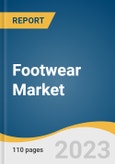In addition, the growth of e-commerce and omnichannel retail strategies has made it easier for consumers to access a broader range of footwear products and brands, contributing to the overall demand. In September 2022, Xero Shoes, the U.S.-based Barefoot Footwear Brand, announced the launch of an e-commerce platform to sell directly to consumers (DTC). This strategy helped the company to strengthen its connection with customers and gain greater control over its distribution channels. The non-athletic segment held a major share of the footwear market in 2023. The non-athletic category consists of flats, heels, mules, sandals, sneakers, and boots, which can be worn on different occasions. This product category is heavily influenced by fashion trends, with consumers seeking stylish and trendy options for casual wear, social occasions, and various lifestyle activities.
Moreover, luxury brands recognize the importance of using sustainable materials in their footwear production. For instance, in August 2022, Louis Vuitton announced the launch of sustainable unisex sneakers. The sneaker is made of recycled organic materials, such as corn-based plastic and recycled polyurethane, cotton & polyester. In addition, the growing aging population across the globe has created a demand for comfortable and supportive non-athletic shoes designed for older individuals, such as slip-resistant shoes and orthopedic footwear. The women's footwear segment held the largest share in 2023. The growing influence of social media, celebrity endorsements, and fashion bloggers has amplified trends, with women seeking footwear that aligns with current fashion aesthetics. Moreover, an increasing number of working women is driving the demand for comfortable, stylish, and durable footwear that can keep up with their demanding schedules.
Moreover, the athleisure trend has fueled the demand for comfortable, stylish, and versatile footwear for athletic and casual occasions. Asia-Pacific accounted for the largest share of the market. This can be attributed to a large and rapidly growing population, particularly in countries like China, India, and Southeast Asian nations. Rapid urbanization, expanding middle-class population, and rising disposable incomes in these countries have led to an increased demand for various types of footwear, including casual, athletic, and formal styles. Moreover, the development of modern retail formats, such as shopping malls and specialty footwear stores, has facilitated increased footwear sales and brand exposure in the region. In addition, several Asia-Pacific countries, such as China, Vietnam, Thailand, India, and Indonesia, are major footwear manufacturing hubs, contributing to the region's availability and affordability of footwear products.
Footwear Market Report Highlights
- According to findings from the 2022 PowerReviews’ State of Apparel & Footwear Shopping survey, a remarkable 74% of footwear purchases are now being made online. Casual footwear emerges as the most sought-after category, commanding a staggering 96% of online sales, closely trailed by athletic footwear, which captures 84% of the online market.
- In August 2023, the AR Mirrors by ZERO10 animated the JD Sports x Nike Need it Now collection, enabling shoppers at JD Sports’ Times Square New York and State Street Chicago flagship stores to virtually try on 18 items. Some items were accompanied by additional AR enhancement effects, such as water droplets.
- The footwear market presents a plethora of opportunities for brands and manufacturers to capitalize on various emerging trends and consumer preferences
- The non-athletic accounted for a share of 66.3% of the global revenue in 2024. The non-athletic category consists of flats, heels, mules, sandals, sneakers, and boots, which can be worn on different occasions.
- The women segment accounted for a share of 47.8% of the global revenue in 2024. Comfort and functionality are key drivers in the women's footwear market.
- The footwear market in North America accounted for a share of 25.3% of the global revenue in 2024. North American consumers tend to prioritize footwear that reflects current trends, personal style, and individual expression
This report addresses:
- Market intelligence to enable effective decision-making
- Market estimates and forecasts from 2018 to 2030
- Growth opportunities and trend analyses
- Segment and regional revenue forecasts for market assessment
- Competition strategy and market share analysis
- Product innovation listings for you to stay ahead of the curve
Why Should You Buy This Report?
- Comprehensive Market Analysis: Gain detailed insights into the market across major regions and segments.
- Competitive Landscape: Explore the market presence of key players.
- Future Trends: Discover the pivotal trends and drivers shaping the future of the market.
- Actionable Recommendations: Utilize insights to uncover new revenue streams and guide strategic business decisions.
This product will be delivered within 1-3 business days.
Table of Contents
Companies Mentioned
The major companies featured in this Footwear market report include:- Nike, Inc.
- Adidas AG
- Puma SE
- Geox S.p.A
- Timberland
- Skechers USA, Inc.
- ECCO Sko A/S
- Crocs Retail, LLC
- Under Armour, Inc.
- Wolverine World Wide, Inc.
Table Information
| Report Attribute | Details |
|---|---|
| No. of Pages | 110 |
| Published | May 2025 |
| Forecast Period | 2024 - 2030 |
| Estimated Market Value ( USD | $ 457.09 Billion |
| Forecasted Market Value ( USD | $ 588.22 Billion |
| Compound Annual Growth Rate | 4.3% |
| Regions Covered | Global |
| No. of Companies Mentioned | 11 |









